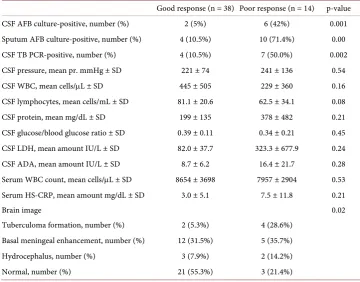Clinical Response to Treatment of Central Nervous System Tuberculosis in Non Human Immunodeficiency Virus Infected Adolescents and Adults
Full text
Figure



Related documents
• If levels are disordered, merge suspect levels B: Execute Rasch analysis on new base model. • Check
All patients were diagnosed based on complete blood count, bone marrow examination including bone marrow aspiration and reverse-transcriptase polymerase chain reaction (RT-PCR)..
When a test case is marked as redundant type 1, it will be checked for redundancy type 2 processes too. The second phase has been defined as redundancy type 2, whereby the
The title compound, (I), a potential substrate for the synthesis of biologically active compounds, forms centrosymmetric triclinic crystals with one molecule in the asymmetric
Chapter III: Effect of 1-alpha-hydroxy-vitamin-D 3 on Performance, Bone Development, Meat Yield and Quality and Mineral Digestibility in Grower Diets Containing Different
Therefore, the very large negative F2-layer storm eect on 3 April 1992 is mainly a consequence of the strong electric ®eld ( E » 85 mV/m), rather than of changes in
In the MMTV- PyMT model we found no deficit in neutrophil accumula- tion at early-mid stages of tumor development (6 and 8 weeks), but by 10 weeks the neutrophil count in sections
Be- tween 2008 and 2013, public health teams in primary care trusts (PCTs) and subsequently local authorities (LAs) commissioned community outreach providers to conduct Health Checks